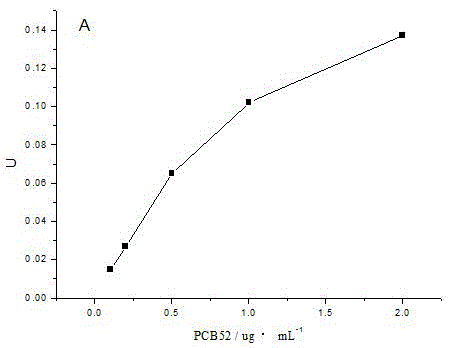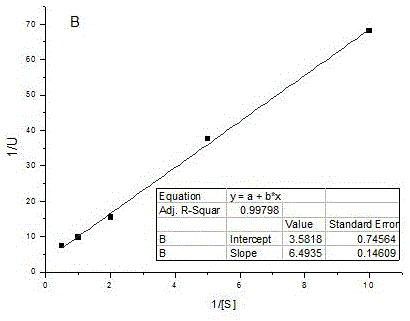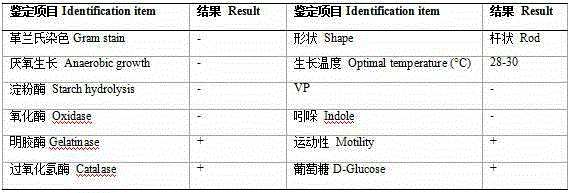Pseudomonas strain and screening method thereof
A technology for pseudomonas and strains, which is applied in the field of Pseudomonas strains and their screening, and can solve the problems of difficulty in maintaining the biomass of PCBs and unsatisfactory application results.
- Summary
- Abstract
- Description
- Claims
- Application Information
AI Technical Summary
Problems solved by technology
Method used
Image
Examples
Embodiment 1
[0022] Embodiment 1, the preparation of culture medium
[0023] 1) Synthetic medium:
[0024] Solution A: 56.77g·L -1 K 2 HPO 4 , 21.94g·L -1 K H 2 PO 4 , 12.96g·L -1 (NH 4 ) 2 SO 4 ;
[0025] Solution B: 0.3g·L -1 CaCl 2 ·H 2 O, 19.5g L -1 MgSO 4 , 5g·L -1 MnSO 4 ·H 2 O, 1g L -1 FeSO 4 ·7H 2 O;
[0026] Solution C: 0.1g·L -1 Yeast extract.
[0027] Liquid synthetic medium (LSM): 77.5mL A solution + 10mL B solution + 910mL LC solution + 2g biphenyl, pH7.2.
[0028] Solid synthetic medium (SSM): 77.5mL A solution + 10mL B solution + 910mL LC solution + 2g biphenyl + 15g agar, pH7.2.
[0029] 2) LB medium:
[0030] Liquid LB medium (LLB): 10g L -1 Peptone, 5g·L -1 Yeast extract, 10g·L -1 NaCl, pH 7.2.
[0031] Solid LB medium (SLB): 1000 mL LLB + 15 g agar, pH 7.2.
Embodiment 2
[0032] Embodiment 2, the acquisition of bacterial strain
[0033] 1) Screening: collect 1g of clover rhizosphere soil not polluted by PCBs, break it up with 10mL sterile water, take 1mL of the suspension in 100mL of LSM, and culture it at 28°C and 150rpm for 5-7d; take 1mL of the bacterial suspension in In the new 100mLSM, transfer 5 times;
[0034] 2) Isolation: Take 200 μL of the bacterial suspension from the last subculture and spread it in SSM, and culture it at 30°C for 4 days to obtain a single colony;
[0035] 3) Purification: Pick a single colony and streak it on the SLB medium for 3 times to obtain pure strains;
[0036] 4) Obtaining: the pure strain in 3) is made into a bacterial suspension, and spread on an SSM plate. Cultivate it statically at 28°C, select a strain that grows fast and well, and name it SYC01, and store it on the SLB slope.
Embodiment 3
[0037] Embodiment 3, the identification of bacterial strain
[0038] 1. Morphological and physiological and biochemical characteristics
[0039] The strain SYC01 was inoculated on the SSM plate and cultured statically for 4 days at 28°C. The morphological characteristics of the colonies and cells were observed, and physiological and biochemical experiments were carried out.
[0040] The observed and experimental results are as follows:
[0041]1) Colony characteristics: The diameter of the colony is 0.5-1.0mm, the colony is round, the surface is smooth and moist, the edges are neat, slightly raised, and yellow.
[0042] 2) Cell morphological characteristics: the cells are rod-shaped with blunt apex; Gram staining is negative; the cell size is 0.5-0.6 μm×1.0-2.6 μm.
[0043] 3) Physiological and biochemical characteristics:
[0044]
[0045] 2. PCR amplification and sequence determination of the 16SrDNA gene of strain SYC01
[0046] Preparation of SYC01 total genomic DNA...
PUM
| Property | Measurement | Unit |
|---|---|---|
| diameter | aaaaa | aaaaa |
Abstract
Description
Claims
Application Information
 Login to view more
Login to view more - R&D Engineer
- R&D Manager
- IP Professional
- Industry Leading Data Capabilities
- Powerful AI technology
- Patent DNA Extraction
Browse by: Latest US Patents, China's latest patents, Technical Efficacy Thesaurus, Application Domain, Technology Topic.
© 2024 PatSnap. All rights reserved.Legal|Privacy policy|Modern Slavery Act Transparency Statement|Sitemap



